
Learning ways to take care of your teeth at home can help you keep your teeth for a lifetime. In fact, with advancements in the health sciences and an increased emphasis on preventive dentistry, older adults are keeping their natural teeth longer than at any time in our history. As a result, in our practice we are very focused Do-It-Yourself Dentistry – primarily this includes helping patients fight plaque and prevent gum disease.
Most DIY dental techniques are aimed at fighting plague -- a sticky, colorless layer of bacteria which accumulates on your teeth. When you eat carbohydrates (foods made of sugar or starch) you feed the plaque, which in turn, produces acids that attack tooth enamel, causes cavities, and develops into a hard substance called calculus (tartar). Uninterrupted, these acid attacks from plaque can result in tooth decay and gum disease (also known as periodontal disease). Left untreated, gum disease can cause loss of teeth and bone.
You can begin the fight with plaque and keep your teeth and gums healthy at any age. It’s really quite easy. Simply:
- Brush your teeth twice a day with a soft-bristled toothbrush and fluoride toothpaste to remove food particles and plaque from the tooth surfaces. In addition to brushing your teeth, be sure to brush the top surface of your tongue to eliminate bad breath and bacteria buildup. During an oral exam, we may recommend you use a power toothbrush to ensure you do not miss critical areas on your teeth and gums. A power toothbrush not only helps you brush longer, but enables you to reach areas in your mouth you may have been missing with a manual toothbrush. (How to Brush your Teeth)
- Clean between your teeth daily with floss or an interdental cleaner. Decay-causing bacteria can linger between teeth where toothbrush bristles cannot reach. Flossing removes plaque and food particles from between the teeth and under the gum line. (How to Floss Your Teeth)
- Look for the ADA Seal of Acceptance when choosing any dental product. The ADA Seal on a product is your assurance that it has met ADA criteria for safety and effectiveness. Look for the ADA Seal on fluoride toothpaste, toothbrushes, floss, interdental cleaners, oral irrigators and mouth rinse.
- Eat a balanced diet and limit between-meal snacks. If a snack is needed, nutritious low-sugar foods such as raw vegetables, plain yogurt, cheese or a piece of fruit should be chosen.
- Schedule regular check-ups with our offices for professional cleanings and oral exams. Although most people require this check-up at 6 month intervals, we may recommend a 3-4 month recall schedule if you have a propensity for tartar build-up or need closer monitoring.
- Ask us about dental sealants, a protective plastic coating that can be applied to the chewing surfaces of the back teeth where decay often starts.
- Wear mouth protection such as a mouthguard when you play contact sports or extreme sports.
Gum disease (also called periodontal disease) is an infection of the tissues supporting your teeth caused by plaque, a sticky film of bacteria that constantly forms on the teeth. These bacteria create toxins that can damage the gums and supporting bone. Gum disease is a major cause of tooth loss in adults. But, because gum disease is usually painless, most patients do not know they have it. Regular dental checkups and oral exams ensure early detection and treatment of all stages of gum disease.
Periodontal (gum) disease attacks just below the gum line in a v-shaped crevice called the sulcus, where they cause the attachment of the tooth and it’s supporting tissues to break down. As the tissues are damaged, the sulcus develops into a pocket; generally, the more severe the disease, the greater the depth of the pocket. As part of each oral exam we measure the depth of the sulcus between your tooth and gums to identify whether you have gum disease. If gum disease is detected, we then determine its severity to ensure proper treatment.
- Normal, healthy gums: Healthy gums and bone anchor teeth firmly in place.
- Gingivitis: Early stage of gum disease-- gums become red, swollen and bleed easily. At this stage, the disease is still reversible and can usually be eliminated by daily brushing and flossing.
- Periodontitis: Unremoved plaque hardens into calculus (tartar). As plaque and calculus continue to build up, the gums begin to recede (pull away) from the teeth, and pockets form between the teeth and gums.
- Advanced periodontitis: The gums recede farther, destroying more bone and the periodontal ligament. Teeth — even healthy teeth — may become loose and need to be extracted.
Below are some of the factors that increase the risk of developing periodontal disease:
- Smoking or chewing tobacco.
- System-wide diseases such as diabetes, cancer, AIDS.
- Some types of medication such as steroids, some types of anti-epilepsy drugs, cancer therapy drugs, some calcium channel blockers, oral contraceptives and some antidepressants can affect oral health.
- Hormonal changes in girls and women. These changes can make gums more sensitive and make it easier for gingivitis to develop.
- Crooked teeth can create hard to reach areas that continuously collect food.
- Fillings that have become defective
- Research shows that increased levels of stress can make it more difficult for our bodies to fight, infection, including periodontal disease.
- Some people are more genetically prone to severe periodontal disease than others.
If you notice any of the following signs of gum disease, call our offices to schedule an appointment with the dentist as soon as possible:
- Gums that bleed easily
- Red, swollen, tender gums
- Gums that have pulled away from the teeth
- Persistent bad breath or bad taste
- Pus between your teeth and gums
- Permanent teeth that are loose or separating
- Any change in the way your teeth fit together when you bite
- Any change in the fit of partial dentures
Please note: It is possible to have periodontal disease and have no warning signs – this is why regular dental checkups and periodontal examinations are critical to your oral health. Treatment methods depend on the type of disease and how far the condition has progressed.
Maintaining good personal oral hygiene at home and ensuring regular dental checkups are both essential to keep periodontal disease from becoming more serious or recurring. You don’t have to loose teeth to periodontal disease. Brush, clean between your teeth, eat a balanced diet, and schedule regular dental visits for a lifetime of healthy smiles.
Back to Top
| |
 |
|
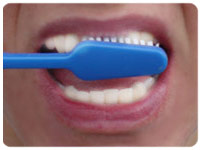 |
|
| |
1. Place your toothbrush at a 45-degree angle against the gums. |
|
2. Move the brush back and forth gently in short circular strokes. Remember not to ‘scrub’ your gums. |
|
| |
|
|
|
|
| |
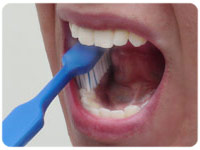 |
|
 |
|
| |
3. Brush the outer tooth surfaces, the inner tooth surfaces, and the chewing surfaces of the teeth. |
|
4. Use the tip top of the brush to clean the inside surfaces of the front teeth, using a gentle circular stroke. |
|
| |
|
|
|
|
| |
5. Brush your tongue to remove bacteria and freshen your breath. |
|
|
|
Note: You should replace your toothbrush every three or four months — or sooner if the bristles become frayed. A worn toothbrush will not sufficiently clean your teeth. Children’s toothbrushes often need replacing more frequently than adults because they can wear out sooner.
| |
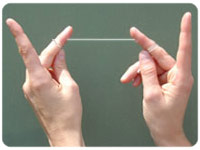 |
|
 |
|
| |
1. Break off about eighteen inches of floss and wind a loop of it around one of your middle fingers. Wind another loop around the same finger of the opposite hand. This finger will take up the floss as it becomes used. Hold the floss tightly between your thumbs and forefingers. |
|
2. Use your thumbs and forefingers to guide about one inch of the floss between your teeth. Move the floss toward the gum in a gentle rubbing motion. Never snap the floss into the gums. |
|
| |
|
|
|
|
| |
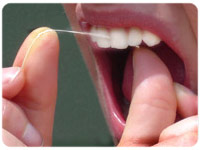 |
|
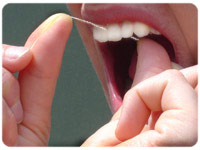 |
|
| |
3. When the floss reaches the gum line, curve it into a C shape against one tooth. Gently slide it into the space between the gum and the tooth. |
|
4. Hold the floss tightly against the tooth. Gently rub the side of the tooth, moving the floss away from the gum with up and down motions. |
|
| |
|
|
|
|
| |
5. Repeat this method on the rest of your teeth. |
|
6. Don't forget the back side of your last tooth. |
|
Note: People who have difficulty handling dental floss may prefer to use another kind of interdental cleaner. These aids include special brushes, picks, and sticks. If you use interdental cleaners, ask your doctor about how to use them properly to avoid injuring your gums.

Back to Top
|